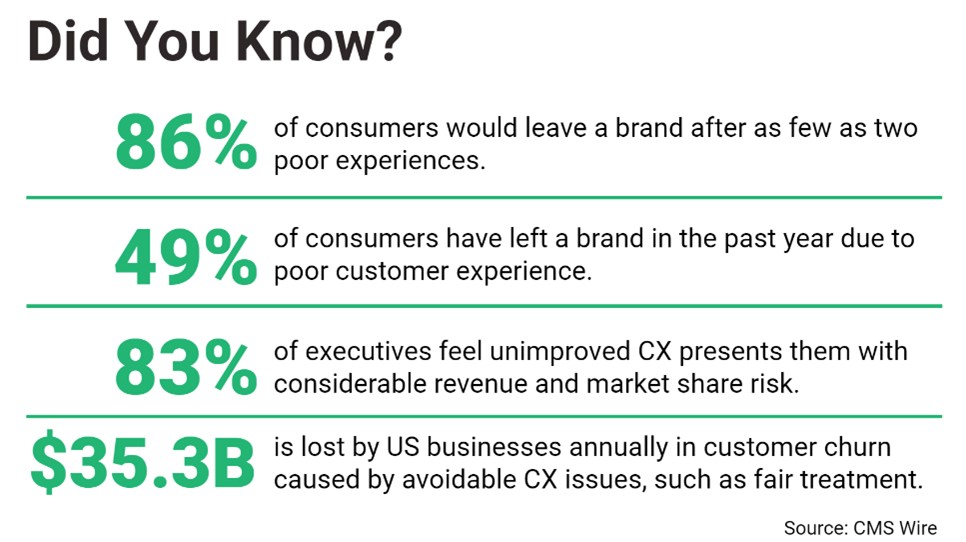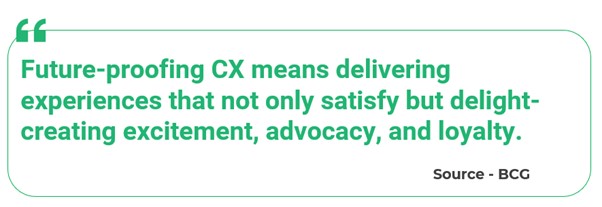
“There are only two things that matter in business: getting and keeping customers.”
- Milton Hershey, founder of The Hershey Company. These wise words illuminate the importance of prioritizing customer experience strategy.
Imagine being able to anticipate your customers’ needs before they even voice them. Providing an experience that goes beyond satisfying your customers to delighting them and turning them into loyal brand advocates. This is what an effective customer experience strategy can do for you.
The customer experience, or CX, encompasses every interaction a customer has with your business, from initial contact to the final touchpoint. It transcends good service, aiming to create meaningful value for customers. Crafting a customer experience strategy through projects or initiatives that align with your business and customer needs is crucial. Measuring and enhancing customer experience performance, staying abreast of CX trends and innovations, and leveraging CX-optimizing AI technology solutions to improve your bottom line and competitive advantage are key to business success. This article delves into the fundamentals of CX, exploring its significance and business impact, outlining its key elements, and ways to build a robust customer experience strategy. In addition, the article explores the transformative potential role of AI solutions for delivering exceptional customer experience through successful project execution.
What Is Customer Experience Strategy?
 A customer experience strategy is a comprehensive plan that guides all customer interactions with a business. It encompasses both pre-sale and post-sale interactions, aiming to provide a positive and meaningful experience at every customer engagement point.
A customer experience strategy is a comprehensive plan that guides all customer interactions with a business. It encompasses both pre-sale and post-sale interactions, aiming to provide a positive and meaningful experience at every customer engagement point.
The above illustration is based on information provided at CMS Wire and collated from various credible surveys and research reports.
Understanding customer needs is essential and a key priority for developing customer experience strategies. By integrating AI-driven predictive analytics, organizations can bridge the gap in customer expectations by transforming insights into actionable steps for an optimal customer journey, leading to successful project outcomes and business growth. This approach not only guides technology investments but also scales them effectively, fostering customer loyalty and amplifying financial performance.
A well-crafted customer experience strategy is a meticulously planned approach to conceptualizing, organizing, and enhancing customer experience strategy to align with business objectives. A holistic customer experience strategy orchestrates successful project execution, and optimal customer communication. AI-powered solutions streamline projects, ensuring a seamless journey for every customer.

Why Is Customer Experience Strategy Important for Your Business?
Customer experience strategy is a key focus area for companies, as it significantly reduces customer churn and positively impacts a company's bottom line.
Every action taken by a firm influences the customer's perception of your company. But why exactly does customer experience matter so much?
Delivering an exceptional customer experience is a pivotal focus area, significantly reducing customer attrition and driving profitability. Every brand interaction shapes customer perception, underscoring the seamless, positive experience's importance. Here’s why it matters:
- Growth Catalyst - 74% of leaders cite customer experience as instrumental to brand loyalty. Happy clients are loyal to a brand, leave positive reviews, and spread word-of-mouth marketing - which is exactly what every business wants.
- Competitive Differentiator - Research confirms customer experience is the top priority, surpassing price, and product quality considerations. In competitive markets, customer experience can make or break a firm's position. Failure to align with evolving needs risks customer churn.
- Maximizing Customer Lifetime Value - Customer lifetime value represents the total revenue generated per customer. Customers are invaluable assets; consistently increasing lifetime value fosters growth and profitability. A strategic customer experience approach enhances loyalty and elevates lifetime value contribution.
- Mitigating Attrition Risks - Customer retention remains a challenge, necessitating controlling churn as a priority. Even a 5% increase in customer retention can yield up to 95% higher profits.
Leveraging AI-powered predictive intelligence solutions enables organizations to deliver unparalleled customer experiences across all interaction points, driving project success and optimizing business outcomes.
What Makes a Great Customer Experience Strategy?

In today's competitive landscape, exceeding customer expectations is essential. A true customer experience strategy goes beyond mere satisfaction, emphasizing a superior experience at every interaction. This commitment to excellence is deeply interwoven with effective project execution, which is critical to delivering on promises and driving business success.
Every customer-driven experience or business strategy initiative ultimately drills down to projects, which are the fundamental building blocks of sustained value creation and competitive advantage. These projects, when executed effectively, translate strategic visions into tangible outcomes that resonate with customers and differentiate a business in the marketplace. Implementing a robust customer experience strategy through meticulously managing projects is paramount to achieving long-term success.
This necessitates a customer-centric innovation culture ingrained within your organization, empowering every employee to surpass these expectations:
- Understanding Requirements - Deploy AI-driven solutions for custom experiences. Predictive intelligence allows you to foresee and cater to stakeholder needs, surpassing customer expectations and fostering trust. This approach enhances the customer experience significantly. Studies reinforce this impact: 49% of customs make decisions based on personalization, per various surveys and research reports collated by CMS Wire.
- Addressing the pain points - Identify strategic projects and initiatives, through customer pain points and deploy modern solutions that predict needs and provide timely, data-driven responses, minimizing friction in the customer journey. This proactive approach not only enhances customer satisfaction but also streamlines the path to business gains, leading to increased loyalty and repeat business.
- Being consistent - Prioritize consistent and regular collaboration, along with feedback communication throughout projects and strategic initiatives, to ensure the fulfillment of our commitments. This dedication to teamwork and process clarity is crucial for delivering a seamless and exceptional customer experience across all interactions.
- Upskilling regularly - Empower employees with modern AI-driven technology to enhance their productivity and deliver superior results. A customer-centric approach is key to promoting proactive problem-solving and innovative solutions. Exceptional service stems from collective effort and cross-departmental collaboration on intricate customer issues.
By embracing these principles and leveraging AI in projects, you can transform your customer experience strategy into a powerful engine for growth. Remember, delightful experiences not only build loyalty but also fuel repeat business and brand advocacy, propelling your business and projects toward sustainable success.
How to Build an Effective Customer Experience Strategy
Projects play a crucial role in enhancing customer experience (CX) strategy by allowing organizations to identify, prioritize, and implement initiatives aimed at improving the overall customer journey. The integration of AI-driven insights and predictive intelligence is transforming the approach to customer experience strategy, making it a strategic asset for project success and business growth. Here’s how this integration reshapes the customer experience strategy within projects:
- Develop Customer Personas - Understand your audience to build detailed customer personas, segmented by demographic, geographic, psychographic, and behavioral data, inform project decisions and customer experience strategy enhancements.
- Establish a Stakeholder Management Plan - Collaborate with stakeholders and engage all relevant teams, from product development to customer service, ensuring their needs align with the project’s CX objectives.
- Map the Existing Customer Journey - Conduct a thorough analysis of the customer journey allows project managers to pinpoint improvement areas, aligning project milestones with stakeholder expectations for a seamless experience.
- Plan Future Customer Experiences - Design projects with adaptability in mind, incorporating customer feedback and predictive analytics to anticipate needs and refine the customer experience strategy.
- Invest in Modern Business Solutions - Utilize modern AI-driven solutions to manage and optimize digital interactions within projects, ensuring personalized and efficient customer experiences.
- Measure CX Metrics - Assess key performance indicators like Net Promoter Score (NPS), Customer Satisfaction Score (CSAT), and Customer Effort Score (CES) are vital for the effectiveness of CX-related project initiatives, guiding ongoing optimization efforts.
- Incorporate Feedback - Collect regular feedback and analyze for iterative project improvement, ensuring that customer experience remains at the forefront of project execution strategies.
Adopting these steps ensures that projects not only meet but exceed customer expectations, fostering brand loyalty and securing a competitive edge in the marketplace.
Example of Customer Experience Strategy
Amazon exemplifies customer-centricity, with CEO Jeff Bezos emphasizing the importance of putting the customer first. Their strategies include:
- Prioritizing customer needs in all initiatives.
- Cultivating a culture of active listening to understand customer needs.
- Offering intuitive project solutions for efficient issue resolution.
This has been possible with the power and capabilities of advanced AI-powered solutions. By leveraging similar solutions, you can optimize your customer experience strategy further to anticipate customer needs, driving greater satisfaction and loyalty.
The below illustration is based on Zendesk’s Customer Experience Trends Report, 2020.

Key Components of a Successful Customer Experience Strategy
Crafting a successful customer experience strategy requires a comprehensive approach that integrates technology, addresses pain points, and prioritizes stakeholder expectations. Here are four essential components every organization should consider when developing their customer experience strategy:
- Addressing the Service Gap - While managing your projects or business initiatives, it’s essential to ensure that the outcomes meet or exceed stakeholder expectations. AI-driven solutions can streamline project processes, improve deliverable quality, and enhance team collaboration. By applying AI to project tasks, teams can achieve more efficient workflows and deliver results that align with project goals.
- Overcoming the AI Readiness Gap - For successful project outcomes, it’s critical to bridge the AI Readiness Gap by embracing technological advancements and fostering a culture of innovation. Investing in AI technology and training enhances project teams’ abilities to utilize intelligent solutions and gain actionable insights. This enables informed decision-making and process optimization, keeping projects competitive and forward-thinking.
- Handling the Integration Gap - Effective project execution requires seamless integration across various systems and platforms. By incorporating AI technologies, project managers can ensure cohesive operations and improved communication within teams. Integrating modern business solutions can also provide a unified view of project metrics, facilitating personalized and strategic project execution approaches.
- Bridging the Communication Gap - Clear and consistent communication is fundamental in project execution. AI-driven solutions can assist in analyzing project data and generating precise updates, enhancing team responsiveness and decision accuracy. Utilizing AI can support continuous project monitoring and engagement, leading to improved team alignment and project success. Closing the Communication Gap with AI helps projects maintain strong stakeholder relationships and deliver outstanding results throughout the project lifecycle.
By incorporating these key components into their customer experience strategy projects and utilizing AI solutions, organizations can differentiate themselves in the market, drive customer loyalty, and achieve sustainable growth.

Conclusion
In today's highly competitive business landscape, the significance of a robust customer experience strategy cannot be overstated. It transcends the mere execution of tasks, striving instead to establish enduring value and meaningful engagements for clients. This strategic approach involves execution of business initiatives through the integration of predictive intelligence, thereby enabling proactive anticipation of issues and successful delivery in line with customer expectations.
However, executing such a customer experience strategy effectively necessitates the right technological support. This is where TrueProject, a SaaS-based predictive intelligence solution, emerges as a pivotal player. TrueProject ensures that every business initiative or project is nothing but a major win for the customer. TrueProject empowers organizations by providing real-time insights, actionable data-driven intelligence, and seamless collaboration functionalities. By proactively identifying potential risks and ensuring alignment with client expectations, TrueProject ensures timely project delivery, thereby enhancing satisfaction and maximizing project value.
Ultimately, the ability to consistently deliver exceptional project outcomes and exceed client expectations lies at the heart of organizational success. TrueProject, driven by AI-powered insights, ensures that all the essential gaps are addressed for businesses in terms of service delivery, communication, AI adoption, and seamless integration. TrueProject enables companies to confidently navigate complex projects, mitigate risks, and consistently surpass client expectations by providing the insight and foresight that matter, thus being a powerful partner by optimizing your customer experience strategy. Therefore, by embracing TrueProject, organizations can solidify their position as leaders in project excellence, driving optimized outcomes for all stakeholders while enhancing their customer experience strategy.
More information on TrueProject at trueprojectinsight.com

About the Author:
Nisha Antony is an accomplished senior marketing communications specialist at TrueProject and a leader in predictive intelligence. With over 16 years of experience, she has worked as a Senior Analyst at Xchanging, a UK consulting firm, and as an Internal Communications Manager on a major cloud project at TE Connectivity. She is an insightful storyteller who creates engaging content on AI, machine learning, analytics, governance, project management, cloud platforms, workforce optimization, and leadership.
Endnotes
- Erin Hueffner. “Customer experience - strategies, importance and examples.” Zendesk Blog - September 20, 2023. https -//www.zendesk.com/in/blog/why-companies-should-invest-in-the-customer-experience/
- Christine Astorino, Karen Lellouche Tordjman, Phil Gerrard, Dutch MacDonald, Julie Hess, Barbara Haen, and Rob Bell. “Don’t Just Improve Your Customer Experience. Future-Proof It.” Boston Consulting Group - June 15, 2023. https -//www.bcg.com/publications/2023/five-principles-to-improve-customer-experience
- Roman Shvydun. “Top Customer Experience Trends That Will Define 2023.” CDP - (n.d.) https -//cdp.com/articles/customer-experience-trends-2023/
- Christopher Lowe. “Customer Experience Trends - 12 to Explore in 2023.” Insider - August 18, 2022. https -//useinsider.com/customer-experience-trends-to-explore-in-2023/
- Carly Stec. “How to Define a Customer Experience (CX) Strategy.” Hubspot - July 20, 2021. https -//blog.hubspot.com/service/customer-experience-strategy
- Emplifi Team. “Top Customer Experience Statistics You Need to Know in 2023.” CMS Wire: Jan 2, 2023. https://www.cmswire.com/customer-experience/top-customer-experience-statistics-you-need-to-know-in-2023/
- Yuvika Iyer. “How to Build a Customer Experience Strategy.” Wrike: Jun 28, 2022. https://www.wrike.com/blog/how-to-build-customer-experience-strategy/




